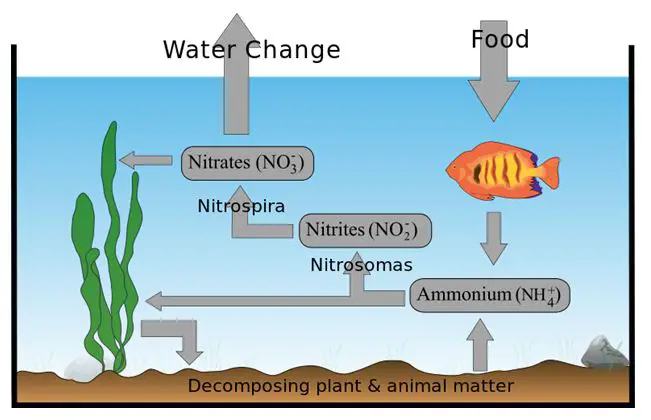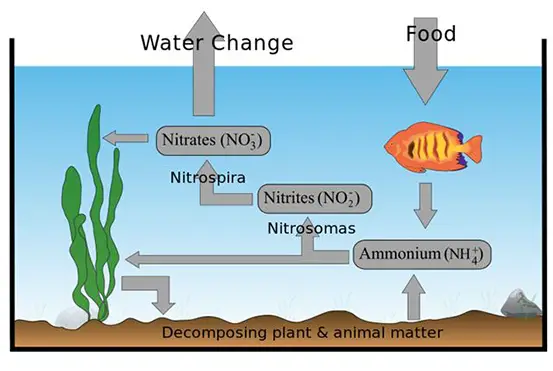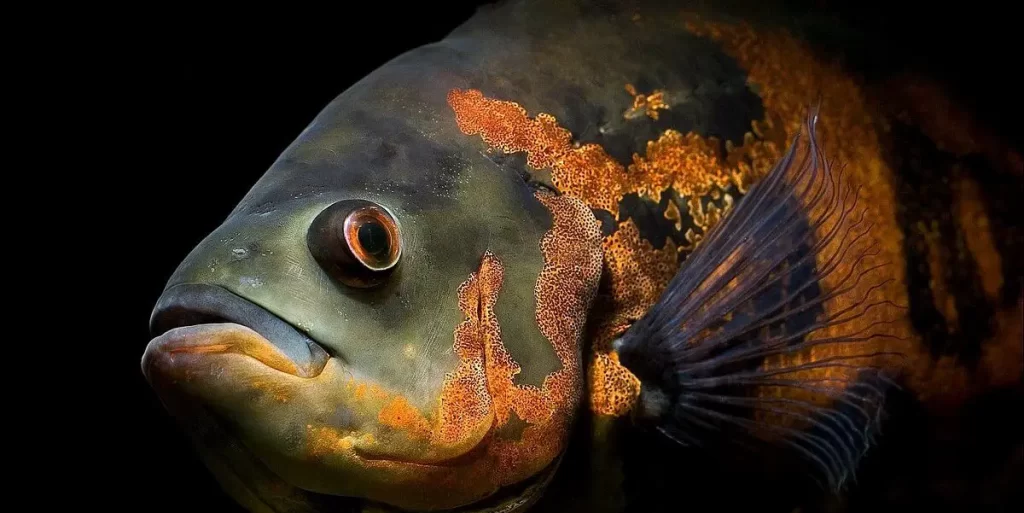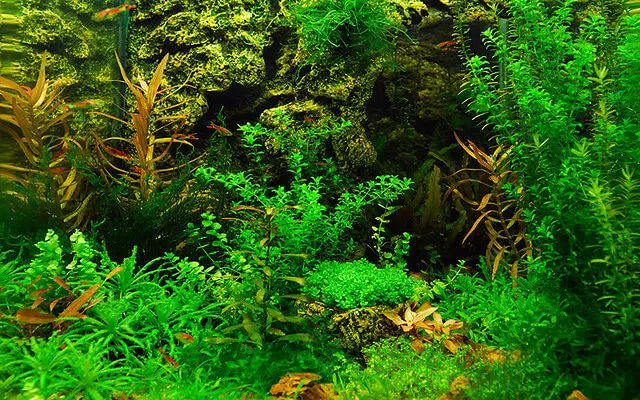First, let us imagine you purchased a decent sized aquarium. You add decorations to your tank and fill it with water. What do you do next? You add your fish, right? Hold On!!! This is where things go wrong. If you add your fish right away, you are eventually killing them. Before you add your fish to your tank, there is one crucial thing you need to do: the Aquarium Nitrogen Cycle. Yes, you heard me right; you must cycle the tank first.
To a beginner, the nitrogen cycle is the most confusing part. Even I had a problem understanding the cycling process at the beginning. I had lost much Fish when I was a beginner, not following this process. Now, as I am a professional in this sector, I am here to help you guys so that you won’t have to lose your Fish as I did. In this article, I am going to help you understand the following topics listed below.
What is the Aquarium Nitrogen Cycle?
You may have heard about the nitrification process or biological cycle. They all refer to the same thing -The Nitrogen Cycle.
Before I explain to you the steps to perform the nitrogen cycle, it is essential for you to what happens in the cycling process.
First, let us imagine that you are surrounded by your own poop and pee all day, every day. Would you like that? Won’t you feel horrible and sick? Your fish feels the same.60
Anyone how studied biology in their primary schools will know that any waste that decay releases ammonia. Likewise, the poop, pee, other decomposed organic waste from the dead plant, leaves brakes down and releases ammonia into the water. Ammonia is a toxic substant that will kill your fish.
Luckily, there is a process, the aquarium nitrogen cycle, which helps to avoid the horrible end.
Aquarium Nitrogen Cycling is the most crucial part of setting up a new aquarium. But, you don’t need to worry, most of the cycling process is automatic, i.e., it happens on its own. But the question is – how to start a nitrogen cycle in an aquarium?
Nitrogen Cycle is a four-step process. For this, you encourage beneficial bacteria to colonize and become established in your tank media and filter. Next is the process of breaking down nitrogenous waste as ammonia produced by fish and dead plants into Nitrite (toxic), then nitrates, less harmful components.
If you fail to understand the cycle process, you are putting significant stress on the fish and eventually killing them. Learning about the cycle and dealing with the critical period will significantly increase your chance of effectively and efficiently keeping the fish.
Why do We Cycle?
The Fishless aquarium nitrogen cycle accumulates the beneficial bacteria that convert toxins into less harmful substances, i.e., ammonia into Nitrite and Nitrite into Nitrate. Ideally, ammonia and nitrite levels should measure 0 ppm (parts per million).
The only reason we cycle our aquarium is to make the aquarium water fish-friendly and to keep your fish healthy.
Treat the water for chlorine before beginning the cycling process. Chlorine will kill the cultures of beneficial bacteria created by the cycling process, which hinders the process of cycling. Do not treat the water with other chemicals in the cycling process once water is dechlorinated. Let it cycle naturally.
What Happens If You Don’t Cycle Your Aquarium?
Nitrogen Cycle is a process that will definitely take place in your aquarium, whether you want it or not.
If you add your fish immediately after filling up your aquarium, the waste and leftover food break down into ammonia, which is going to start the nitrogen cycle in your aquarium. But the problem is that your fish cannot take the stress. The increase in toxic ammonia and Nitrite is harmful to your fish. So, there is no guarantee that your new fish will survive it. Therefore, it is best that you leave it to the expert’s hand.
How Long Does It Take To Cycle Your Aquarium?
Various shopkeepers are selling products saying it would speed up the cycling process only to sell the product. Some even claim that modern tanks just take 24 hours to cycle.
Let me tell you that the nitrogen cycle is a natural process. It happens on its own. As a beginner, to speed up a little bit, you could use ammonia to kick-start the nitrogen cycle process.
There is no exact time or date for the cycle to complete. It might take two weeks or even two months. It will finish when it ends.
This is because the bacteria that propagate in your tank grow very slowly. All you can do is wait. You need to have patience.
The Need for Beneficial Bacteria
Strange as it may sound, bacteria are vital to the health of an aquarium. The increasing amount of ammonia increases the growth of ammonia-oxidizing bacteria. The ammonia-oxidizing bacteria convert ammonia into nitrites. However, high levels of nitrites are toxic to fishes. There are nitrite-oxidizing bacteria, which convert nitrites into nitrates, which is less toxic to fish and corals. As the amount of ammonia and nitrite fall, homeowners should expect nitrate levels to rise.
High levels of ammonia are vital in stimulating the growth of colonies of beneficial bacteria. Unfortunately, high levels of ammonia can kill other aquatic lives in your tank. The establishment of nitrite-oxidizing bacteria takes time. These colonies often grow slowly and take 30 to 45 days to mature. Be careful when adding ammonia sources. Once the nitrite-oxidizing bacteria start to grow, the ammonia should never surpass five ppm. Extreme levels of ammonia during the nitrogen cycle can paralyze the cycling process.
Nitrifying bacteria provide filtration of the natural biological cycling process, and they are also responsible for breaking down organic waste within the fish tank. It might take several weeks for a good number of beneficial bacteria to grow in a new clean aquarium, and it is better to be patient and let the colony grow properly rather than hasten the formation of the nitrogen cycle. Speeding up the cycling process, unnaturally can create rapid changes in water quality that can harm delicate fish and corals. However, with patience, you can have good bacteria along with healthy water, which will ultimately let your fishless aquarium cycle thrive.
Why is the Aquarium Nitrogen Cycle important?
Unlike nature’s environment, a fish tank is a closed environment for both fish and aquarium waste such as fish waste, uneaten fish food, decaying plant materials, and so on. If you don’t to eliminating those waste, you are creating an unfavorable environment for the fish and eventually killing them.
Even if the water looks clear, don’t get fooled by it, the water might be loaded with toxins, much like a septic tank. This is where the aquarium nitrogen cycle kicks in.
Waste produced by fish and dead plants releases ammonia into the water. Beneficial Bacteria in the filter media like lava rocks, k1 media will convert this ammonia into Nitrite, which is much more toxic than that of ammonia. But another type of bacteria is present in the filter media that feeds Nitrite and converts it into nitrate. At low-level nitrate are not harmful to your fish.
This is the basic step of the aquarium nitrogen cycle, which we will be discussing in detail in this article. And we recommend you to choose the fishless cycling process for the aquarium nitrogen cycle when you are setting up your fish tank for the first time.
Time-Line for the Nitrogen Cycle
Stage 1: Ammonia
As mentioned already, fish wastes are mainly ammonia. Ammonia is also produced from the decomposition of solid waste. Further, the decayed excess fish food also results in the production of ammonia.
Also Read: How To Lower Ammonia In An Aquarium
Stage 2: Ammonia to Nitrite
Bacteria called “nitrosamines” feed on ammonia. Nitrite is a byproduct of these bacteria. The aquarium where a colony of these bacteria is established, ammonia is eliminated, thus eliminates the toxin and the risk to its livestock of the first stage. Unfortunately, nitrites are also toxic for fishes and invertebrates, with effects similar to exposure to ammonia.
Also Read: How To Lower Nitrite In An Aquarium
Stage 3: Nitrite to Nitrate
Once the nitrite level reaches a certain point, Another specific set of bacteria called “nitrobacteria” will develop. They feed on the Nitrite (toxic) and produce nitrate (NO3) (non-toxic). Keeping nitrate to less than around 30 ppm (parts per million) is generally a safe zone. Over time, the nitrate will continue to grow (in an aquarium without plants). This is why you need to perform regular (partial) water changes to keep Nitrate levels in the healthy range.
Doing a regular water change will also benefit your aquarium by removing solid food and fish waste, dissolved organic compounds.
Also Read: How To Lower Nitrate In An Aquarium
Stage 4: Help from the Aquarium Plants
For those of us who maintain living plants, they play an excellent role in completing the final step of the Aquarium Nitrogen Cycle. Living plants consume nitrate as part of photosynthesis. The byproduct that arises from photosynthesis,i.e., oxygen helps oxygenate the water, which is the source of respiration of fish and other animals. For those who uphold very low maintenance, aquariums plants are vital in limiting the accumulation of nitrates.
Different Ways To Perform the Nitrogen Cycle
Now Let’s Look at how to perform a nitrogen cycle
There are two methods you can use to cycle your aquarium: Traditional Method(Cycling with Fish) and Fishless cycling (Cycling without Fish).
Traditional Method
Let me first tell you that cycling your tank with a fish is not the preferred method. You will expose your fish to toxins during this process. This method can also increase stress levels, which causes several diseases.
However, in the traditional method of cycling process, hardy fishes like zebra danios or guppies are used. These fishes produce ammonia in which bacteria feed on start the cycle. Two fishes should be added per 10 gallons of water in a tank.
The fish tank should not be overstocked at this stage since the tank is in its early stage, and the bacteria that feed on ammonia are just beginning to propagate.
Alternative | Fishless cycling
The fishless cycling method is the correct way of cycling your fish tank since it does not risk fish health even if it’s a hardy fish. Some of the alternatives to the traditional method are:
Media from a mature tank
The best choice of fishless cycling is to use the filter media from the old mature aquarium that contains all the beneficial bacteria and aquarium waste. This process helps to introduce bacteria to a new tank from an old tank that has already been cycled. It won’t be required to wait for bacteria to grow naturally. Since the bacteria from an old tank are used, this process boosts up the nitrogen cycle in an aquarium.
Using fish food
The next alternative for the fishless aquarium cycle is to use fish food. It is simple as the process involves sprinkling fish food in a new aquarium. This process takes a little longer time. Over the next few days, the fish food starts to decay and release the waste product containing ammonia into the water.
Using Ammonia
Ammonia can be purchased from any hardware store in the form of a water and ammonia solution. This mixture is toxic. Hence, the ammonia solution should be kept away from pets and children.
For this, fill 3-gallon bucket water, add a drop of ammonia, and stir. Use an ammonia test kit by API test kit to find the concentration of ammonia. It requires 5mg/lt or 5ppm.
Aquarium Nitrogen Cycle Steps using fish
Step 1: Introduce Hardy Fish To you Tank
Your goal here is to increase the ammonia level to 5ppm. So, you need to add those fish that can tolerate high levels of ammonia and Nitrite until the beneficial bacteria grow.
Add approx 1-2 fish per 10-gallons of water. Adding too many fish will lead to excess waste, eventually, increase the toxin level and killing your fish.
Step 2: Feeding Your Fish
You need to make sure that you add only the amount of fish food your fish can eat at a time. Because the more food they eat, the more waste they produce. This increases the toxins level before the beneficial bacteria colonize in your aquarium.
Another reason is that the leftover food will get decomposed, producing more ammonia, i.e., more toxins.
Step 3: Water change
Regular water changes are a must in this process since you need to eliminate the level of toxins that can harm your fish. You need to use ammonia and nitrite test kits so that you can check the toxins level of your tank.
You need to do 10-20% water change every 3-4 days. Any more water change you do will remove ammonia and Nitrite that the beneficial bacteria need to feed on.
Step 4: Test The Toxin Level
For this, you will need to purchase a test kit to monitor your ammonia and nitrite level in your aquarium.
You need to track your toxin level since it will help you manage your fish with the process. As the ammonia and nitrite level drops back down to zero, this signals that the cycling process has finished.
Step 5: Add More Fish
Now that the toxins level has dropped to zero, you can add your fish. But make sure you add them gradually, not at once. After each addition, wait for a week and test the toxin level of your water. If the ammonia and Nitrite are still low, add more.
If the ammonia and Nitrite are high, then do a partial water change and add your fish.
Fishless Aquarium Nitrogen Cycle Steps
In the following steps, we will be discussing the procedure to complete the aquarium nitrogen cycle without risking a fish life. i.e., the Fishless Cycling Process.
Step 1 – Ammonia Dosing:
The fishless cycling process starts with giving a “nitrosamines” bacteria something to eat. We simulate the wastes of fishes by adding ammonia to the fishless cycling process. Add five ppm of ammonia to your aquarium. After adding ammonia, regular ammonia and nitrite tests should begin. You can get away with testing only ammonia and looking for the value you will lose. Your aquarium is a closed system, so when you add the ammonia to 5 ppm, it will remain at five ppm until the “nitrosamines” bacteria develop to sufficient quantities to reduce ammonia. Any drop in ppm of ammonia will soon lead to detectable Nitrite.
Step 2 – Maintain Ammonia and Observe Nitrite Levels:
After dosing ammonia into the tank, the first crew of “nitrosamines” bacteria are in place and produce Nitrite as waste. This waste will be food for the next crew of “nitrobacteria” bacteria. “Nitrosamines” need food to stay alive, so start administering ammonia as needed. You may not need to take doses every day; simply test and add as needed, when ammonia read 0 or 1 ppm, add about two ppm.
Apart from that, it is a waiting game for the second group of bacteria to grow exponentially. You know that this has happened when the Nitrite shows a drop and nitrate is detected in a test. Now you need to make sure that ammonia and Nitrite don’t exceed five ppm. When your tanks Nitrite reading is above five ppm, you need to change water change and then test Nitrite again the next day.
Step 3 – Large Water Change:
After 24 hours of testing, if ammonia and Nitrite are eliminated, you have successfully cycled your aquarium, it is likely that the tank will have a high level of nitrate.
Although nitrate is not toxic at small levels, we can eliminate it and create optimal conditions for incoming cattle. A huge change in water is to be made to get nitrate levels close to zero.
Step 4 – Add your Fish and Other Critters:
Yes, you did it! Your time and perseverance have been worth it, and now you have optimized your tank to receive new fish, shrimp, and any other critters that you are planning. The established beneficial bacteria are strong enough for the full load of the critters in your tank, so it is not necessary to introduce the fish gradually; you can add all your planned occupants at once if you wish. If you delay adding fish, you can continue to administer ammonia daily until you are ready (to keep feeding all the beneficial bacteria). Once you’re ready, just make your big water change to eliminate the nitrate.






